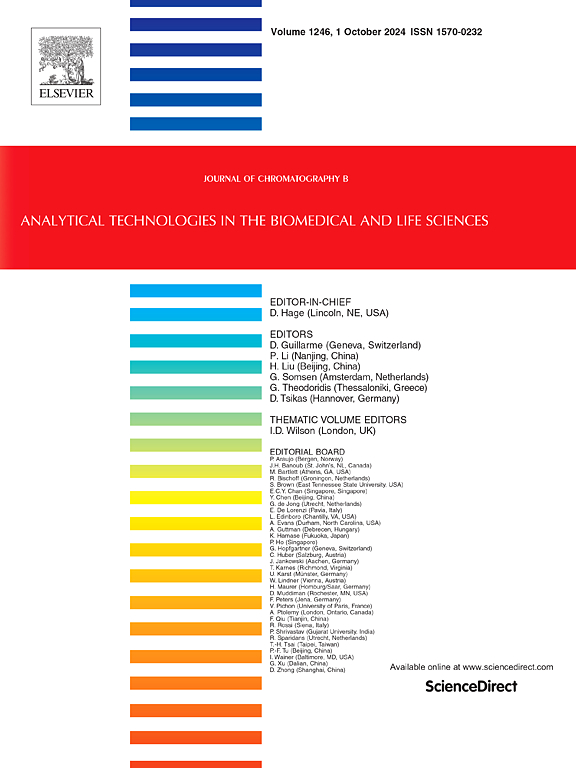Bioanalytical method development of nevirapine, fosamprenavir calcium and its metabolite amprenavir by RP-HPLC in rat plasma
IF 2.8
3区 医学
Q2 BIOCHEMICAL RESEARCH METHODS
引用次数: 0
Abstract
The current analytical work focuses on the development of a bioanalytical method for anti-HIV drugs, nevirapine, fosamprenavir calcium, and its metabolite amprenavir. Fosamprenavir is a prodrug of amprenavir, digested by cellular phosphatases in vivo. Rat plasma was isolated from the collected rat blood by centrifugation and used for preparing stock solutions. A reverse-phase column (ODS C-18) was used for the development of the method and validation. The bioanalytical method was developed using the isocratic mode. The solvent system used is Methanol: Water: ACN (800 mL: 200 mL: 50 mL). The method was run at a flow rate of 0.5 mL/min, and 258 nm was the detection wavelength. The developed method showed retention at 8.705 min for nevirapine, 11.923 min for fosamprenavir calcium, and 14.391 min for amprenavir. The calibration curve was linear with a correlation coefficient (r2) of 0.9916 for nevirapine, 0.9909 for fosamprenavir calcium, and 0.9879 min for amprenavir. The RSD of the accuracy, precision, and stability study of the method was found to be less than 2 % and was found to be acceptable. The method is reliable and does not show any kind of interference due to the plasma sample. Thus, the results support that a reliable, reproducible, and efficient method was developed, and validation was carried out for the estimation of the drug nevirapine, fosamprenavir, and its metabolite amprenavir in rat plasma samples.

大鼠血浆中奈韦拉平、磷普雷那韦钙及其代谢物安普雷那韦生物分析方法的建立
目前的分析工作重点是开发抗hiv药物奈韦拉平、福samprenavir钙及其代谢物amprenavir的生物分析方法。福samprenavir是amprenavir的前药,在体内被细胞磷酸酶消化。从收集的大鼠血液中离心分离大鼠血浆,用于制备原液。采用反相色谱柱(ODS C-18)建立方法并进行验证。生物分析方法采用等压模式。溶剂体系为甲醇:水:ACN (800 mL: 200 mL: 50 mL)。方法以0.5 mL/min流速运行,检测波长为258 nm。奈韦拉平的保留率为8.705 min,磷普雷那韦钙的保留率为11.923 min,安普雷那韦的保留率为14.391 min。奈韦拉平、磷普雷那韦钙、安普雷那韦的相关系数(r2)分别为0.9916、0.9909和0.9879 min。该方法的准确度、精密度和稳定性研究的RSD小于2%,可以接受。该方法可靠,不受等离子体样品的干扰。本研究为奈韦拉平、福samprenavir及其代谢物amprenavir在大鼠血浆样品中的含量测定提供了一种可靠、重复性好、高效的方法。
本文章由计算机程序翻译,如有差异,请以英文原文为准。
求助全文
约1分钟内获得全文
求助全文
来源期刊

Journal of Chromatography B
医学-分析化学
CiteScore
5.60
自引率
3.30%
发文量
306
审稿时长
44 days
期刊介绍:
The Journal of Chromatography B publishes papers on developments in separation science relevant to biology and biomedical research including both fundamental advances and applications. Analytical techniques which may be considered include the various facets of chromatography, electrophoresis and related methods, affinity and immunoaffinity-based methodologies, hyphenated and other multi-dimensional techniques, and microanalytical approaches. The journal also considers articles reporting developments in sample preparation, detection techniques including mass spectrometry, and data handling and analysis.
Developments related to preparative separations for the isolation and purification of components of biological systems may be published, including chromatographic and electrophoretic methods, affinity separations, field flow fractionation and other preparative approaches.
Applications to the analysis of biological systems and samples will be considered when the analytical science contains a significant element of novelty, e.g. a new approach to the separation of a compound, novel combination of analytical techniques, or significantly improved analytical performance.
 求助内容:
求助内容: 应助结果提醒方式:
应助结果提醒方式:


